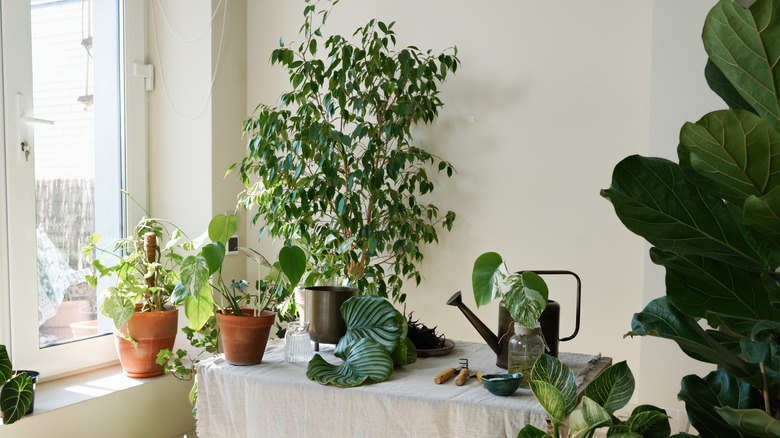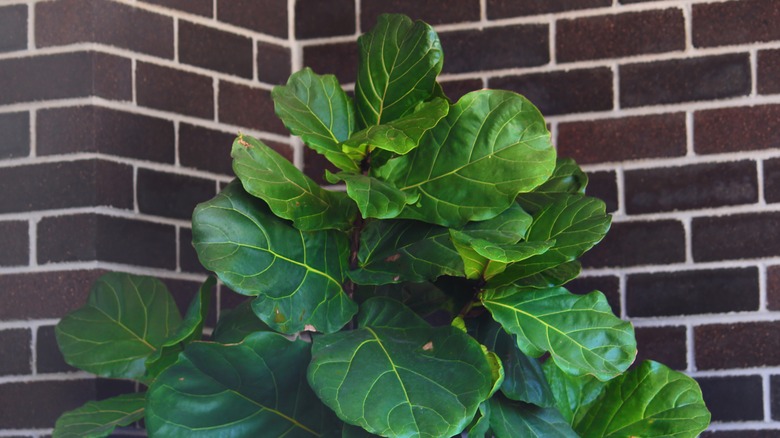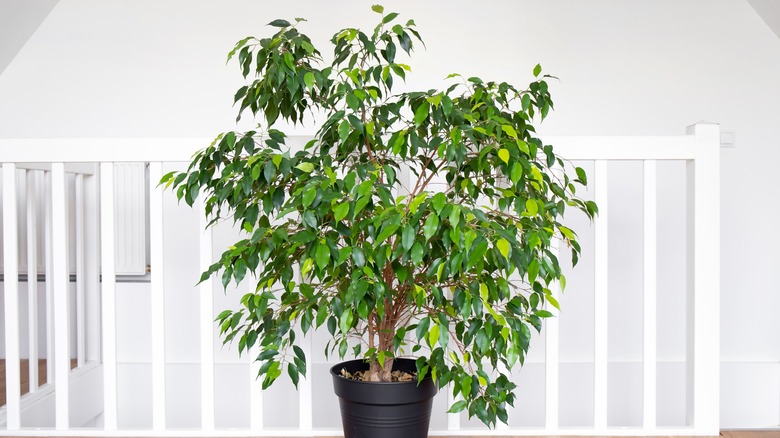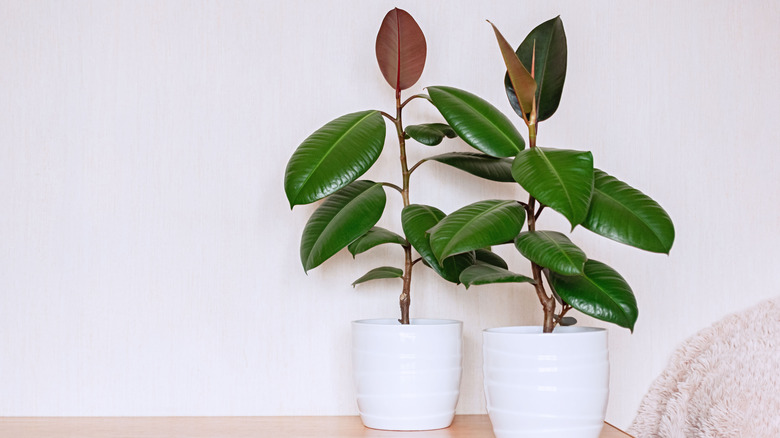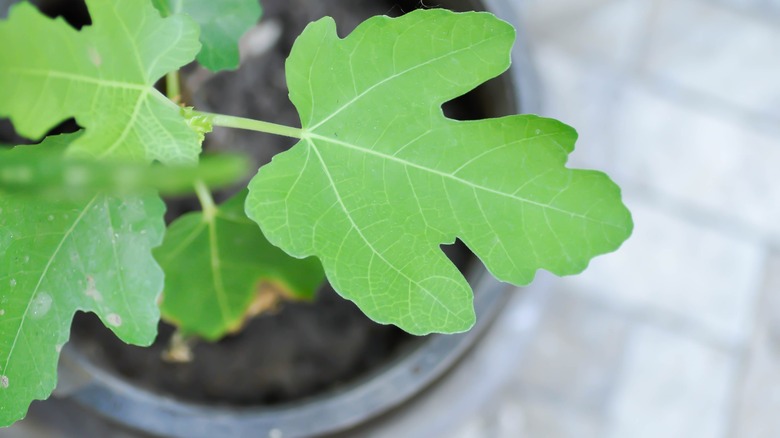Fig Trees You Should Grow Indoors For A Touch Of Green In Your Space
Adding houseplants to your home decor is a great way to bring life and warmth to your space, but some plants do better indoors, while others thrive outside. Fig trees are a popular choice for indoor greenery. There are over 850 different species — and not all of them adapt well to life as a houseplant. Among the most popular fig trees to cultivate indoors is the fiddle leaf fig (ficus lyrata). The unique-looking houseplant has large, structured evergreen leaves that add a touch of drama to your home all year round.
While fiddle leaf fig trees are a popular houseplant, they aren't the only option for adding a touch of green to your indoor space. A few other fig tree species that can do well indoors include the rubber tree (ficus elastica), the weeping fig (ficus benjamina), and the Chicago hardy fig (ficus carica 'Chicago Hardy'). As long as you choose a location with partial shade and make sure to water and fertilize correctly, any of these fig tree species will grow happily and healthily indoors. Just be careful about bringing one into a home with pets or small children, as most species of this plant are toxic when ingested by humans, cats, and dogs. If your pets are notorious plant munchers, the Chicago hardy fig is the most pet-safe species that also does well indoors.
Fiddle Leaf Fig
In addition to looking great, fiddle leaf fig trees also enjoy being potbound, which makes them well-suited to life indoors. While they can soar up to 100 feet tall in their native habitat of Western and Central Africa, fiddle leaf fig trees max out at about 10 feet when grown as houseplants. You can also prune your fiddle leaf fig tree as needed to keep it at your preferred height.
These fig trees have a reputation for being finicky when grown indoors, but it's actually not too hard to properly take care of a fiddle leaf fig. To start, choose a location that gets plenty of sunlight, water regularly, but be careful not to over-water. A healthy fiddle leaf fig has lots of benefits. Not only are they beautiful to admire with their large leaves, but these leaves can help purify the air by absorbing toxins. As a large statement plant, it can also make a big splash in your decor. The New York Times even called it "The 'It' Plant of the Design World."
Weeping Fig
Weeping figs (ficus benjamina) have smaller, more delicate leaves that can help soften the aesthetic of your space. It doesn't mind a bit of afternoon shade, either. So, if you don't have that perfect south or east-facing spot for your plant, this species might be a better fit for your home. This broadleaf evergreen fig tree usually maxes out at about 2 to 10 feet tall when grown in a pot. It also tolerates light pruning when done in late fall or winter, so it's easy to keep the tree at your preferred size. You can even train new stems to intertwine with existing ones to create a braided trunk look that amps up the aesthetic appeal of this potted fig tree.
This is a great indoor fig if you have a spot that gets indirect sunlight while being protected from cold drafts, about 4 to 8 feet away from a window but still in the window's light path. This plant has been cultivated for centuries, as it can produce extracts with many health benefits. In indigenous communities, the fruit extracts of this variety are used to treat inflammations of the skin. The leaves and twigs of the weeping fig can also be used as an insect repellant, making this plant helpful for keeping insects out of your house.
Rubber Tree
Rubber trees (ficus elastica) have large, glossy leaves that range from dark green to a rich maroon, making for a striking accent to your interior decor. If you want a taller, more tree-like shape, limit pruning to just what's needed to maintain the height you want. Alternatively, you can prune more heavily to encourage a fuller, bushier shape. Whichever route you take, wear gloves when pruning because the leaves and stems produce a sap that can irritate your skin. That can also be a problem for pets who chew on or rub against the plant.
For the happiest indoor rubber tree, place it in a well-lit spot further from a window where the temperature doesn't fluctuate much. It also likes drier soil than some other fig species, so make sure to let the soil dry out between watering. If you're growing it in a taller, tree-like shape, you might need to stake it for extra support so it doesn't lean.
Having a rubber tree in your house can be beneficial for your mental wellbeing. They are easy to care for and thus yield gratifying results. Bring a rubber tree into your home, and enjoy your new role as a plant caretaker.
Chicago Hardy Fig
Of the trees discussed in this article, the Chicago hardy fig is the only one that's not toxic to humans or pets. The cold-tolerant tropical plant even produces edible fruits — though your yield on an indoor container-grown tree will likely be low. So, if you're concerned about potential toxicity or you like the thought of harvesting a few tasty figs each year, this is the tree to get. It will bear fruit within 2 to 4 years, and it can be used to make fruit jams and preserves.
During the growing season, let the top one or two inches of the soil dry completely between waterings. Then, water deeply and dump the excess water that drains from the bottom of your pot. If the leaves are unusually small or yellow, you might need to apply a liquid fertilizer occasionally during the growing season. Follow the recommended dosage and timing on the bottle.
Unlike the other fig trees mentioned above, the Chicago hardy fig is deciduous, so it will lose its leaves and go dormant in the winter. If you are hoping for fruit, move them to a colder part of your home after it goes dormant. It shouldn't be left outside to freeze, but it should get at least 100 hours of chilling to keep it dormant until spring and trigger fruit growth when it wakes back up. In addition to keeping it cool, it's important to avoid overwatering during this time as dormant roots don't drink up as much water as they do in spring and summer.
